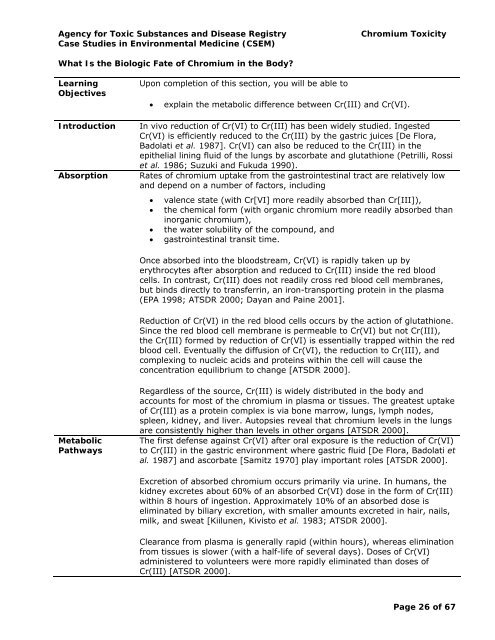(Cr) Toxicity | ATSDR - CSEM - Agency for Toxic Substances and ...
(Cr) Toxicity | ATSDR - CSEM - Agency for Toxic Substances and ...
(Cr) Toxicity | ATSDR - CSEM - Agency for Toxic Substances and ...
Create successful ePaper yourself
Turn your PDF publications into a flip-book with our unique Google optimized e-Paper software.
<strong>Agency</strong> <strong>for</strong> <strong>Toxic</strong> <strong>Substances</strong> <strong>and</strong> Disease Registry Chromium <strong><strong>Toxic</strong>ity</strong><br />
Case Studies in Environmental Medicine (<strong>CSEM</strong>)<br />
What Is the Biologic Fate of Chromium in the Body?<br />
Learning<br />
Objectives<br />
Upon completion of this section, you will be able to<br />
• explain the metabolic difference between <strong>Cr</strong>(III) <strong>and</strong> <strong>Cr</strong>(VI).<br />
Introduction In vivo reduction of <strong>Cr</strong>(VI) to <strong>Cr</strong>(III) has been widely studied. Ingested<br />
<strong>Cr</strong>(VI) is efficiently reduced to the <strong>Cr</strong>(III) by the gastric juices [De Flora,<br />
Badolati et al. 1987]. <strong>Cr</strong>(VI) can also be reduced to the <strong>Cr</strong>(III) in the<br />
epithelial lining fluid of the lungs by ascorbate <strong>and</strong> glutathione (Petrilli, Rossi<br />
et al. 1986; Suzuki <strong>and</strong> Fukuda 1990).<br />
Absorption Rates of chromium uptake from the gastrointestinal tract are relatively low<br />
<strong>and</strong> depend on a number of factors, including<br />
Metabolic<br />
Pathways<br />
• valence state (with <strong>Cr</strong>[VI] more readily absorbed than <strong>Cr</strong>[III]),<br />
• the chemical <strong>for</strong>m (with organic chromium more readily absorbed than<br />
inorganic chromium),<br />
• the water solubility of the compound, <strong>and</strong><br />
• gastrointestinal transit time.<br />
Once absorbed into the bloodstream, <strong>Cr</strong>(VI) is rapidly taken up by<br />
erythrocytes after absorption <strong>and</strong> reduced to <strong>Cr</strong>(III) inside the red blood<br />
cells. In contrast, <strong>Cr</strong>(III) does not readily cross red blood cell membranes,<br />
but binds directly to transferrin, an iron-transporting protein in the plasma<br />
(EPA 1998; <strong>ATSDR</strong> 2000; Dayan <strong>and</strong> Paine 2001].<br />
Reduction of <strong>Cr</strong>(VI) in the red blood cells occurs by the action of glutathione.<br />
Since the red blood cell membrane is permeable to <strong>Cr</strong>(VI) but not <strong>Cr</strong>(III),<br />
the <strong>Cr</strong>(III) <strong>for</strong>med by reduction of <strong>Cr</strong>(VI) is essentially trapped within the red<br />
blood cell. Eventually the diffusion of <strong>Cr</strong>(VI), the reduction to <strong>Cr</strong>(III), <strong>and</strong><br />
complexing to nucleic acids <strong>and</strong> proteins within the cell will cause the<br />
concentration equilibrium to change [<strong>ATSDR</strong> 2000].<br />
Regardless of the source, <strong>Cr</strong>(III) is widely distributed in the body <strong>and</strong><br />
accounts <strong>for</strong> most of the chromium in plasma or tissues. The greatest uptake<br />
of <strong>Cr</strong>(III) as a protein complex is via bone marrow, lungs, lymph nodes,<br />
spleen, kidney, <strong>and</strong> liver. Autopsies reveal that chromium levels in the lungs<br />
are consistently higher than levels in other organs [<strong>ATSDR</strong> 2000].<br />
The first defense against <strong>Cr</strong>(VI) after oral exposure is the reduction of <strong>Cr</strong>(VI)<br />
to <strong>Cr</strong>(III) in the gastric environment where gastric fluid [De Flora, Badolati et<br />
al. 1987] <strong>and</strong> ascorbate [Samitz 1970] play important roles [<strong>ATSDR</strong> 2000].<br />
Excretion of absorbed chromium occurs primarily via urine. In humans, the<br />
kidney excretes about 60% of an absorbed <strong>Cr</strong>(VI) dose in the <strong>for</strong>m of <strong>Cr</strong>(III)<br />
within 8 hours of ingestion. Approximately 10% of an absorbed dose is<br />
eliminated by biliary excretion, with smaller amounts excreted in hair, nails,<br />
milk, <strong>and</strong> sweat [Kiilunen, Kivisto et al. 1983; <strong>ATSDR</strong> 2000].<br />
Clearance from plasma is generally rapid (within hours), whereas elimination<br />
from tissues is slower (with a half-life of several days). Doses of <strong>Cr</strong>(VI)<br />
administered to volunteers were more rapidly eliminated than doses of<br />
<strong>Cr</strong>(III) [<strong>ATSDR</strong> 2000].<br />
Page 26 of 67

















